PARISH OF CLONDUFF
by Dean Anthony
Davies
Clonduff Parish is situated in the barony of Upper
Iveagh (Lr. Half). The parish borders five parishes in the diocese of
Dromore, namely: Kilbroney, Mayobridge, Drumgath, Annaclone and Lower
Drumgooland, and two in the diocese of Down & Connor, Kilcoo and Upper
Mourne. Hilltown, its only village, takes its name from the Hill family
of Hillsborough, descendants of Sir Mayses Hill, a Devonshire man who
came to Ireland in the army of the Earl of Essex 1573, settled in the
lands of Iveagh in Down and greatly increased their possessions until
their estates reached from Lisburn to the Mourne Mountains. Wills Hill
erected a market house, now the Downshire Arms Hotel, and a number of
houses as well as the Protestant Church of St. John's in 1766.
Prior to the Hills coming, the region was known as
the Eight Mile Bridge, that being the distance in Irish miles from
Hilltown to Newry. It was close to this bridge that Redmond O'Hanlon,
the highwayman, was killed on the 25th. April 1681. The parish lies
wholly within the county of Down and the local government district of
Newry and Mourne. Catholics remain the majority population, their number
is estimated to be around 2,700. The modern parish of Clonduff consists
of some 24 townlands. 1n the townland of Carcullion is the village of
Hilltown.
CLONDUFF IN THE EARLY CHRISTIAN TIMES
The history of the parish goes back to the days of
St. Patrick. The locality is rich in the tradition and relics of the
pre-historic past. In the townland of Goward (Guth Ard or High Voice)
stands a cromlech known locally as `Pat Kearney's Big Stone', and is
said to weigh some fifty tons. Legend asserts that it marks the burial
ground of Fionn Mac Cumhaill, the Ulster giant. Across the Bannvale
footbridge in Ballymaghery, to the left of the river, are the remains of
an earthen mound locally called `The Mount'- a relic of the Bronze Age.
Bishop Reeves in his work The Ecclesiastical Antiquities of Down and
Connor and Dromore, gives much interesting information regarding
Clonduff's early history. He mentions that the townlands of Ballyaughian,
Ballymaghery, Ballynanny and Leitrim, then mensal lands of the Bishop of
Dromore, were known as the `Four townlands of Clonduff' and it is from
this curious source that the parish's name is derived. Joyce gives the
old Gaelic name as `Cluain Daimh' � Meadow of the Ox.
A tradition associated with St. Patrick and his
missionary work states that he preached on the Hill of Tamery, which was
within the early Christian parish of Clonduff. The ancient monastery of
Clonduff which was founded from Bangor Monastery, was situated in the
townland of Ballynanny. Its first Abbot was St. Mochommoc of the seventh
century who died in A.D. 655. His Feastday is 26th. December. The exact
site of the monastery is hard to determine but most likely it is the
portion of the townland of Ballynanny which adjoins the Hen Mountain and
is still called Ballychommoc. The old name of the townland was Baile
Chaisil, site of Comgall's castle. The monastery was visited by King
John of England during his Ulster tour in 1210. It appears that, at the
dissolution of the monasteries in King Henry VIII's reign, the lands of
the Rectory of Clonduff claimed by the Abbot of Bangor who still
appointed the vicar of Clonduff, were extended to twenty-two townlands.
The monastery was suppressed and its revenues confiscated about 1538.
However, as Clonduff lay in the Magennis country which was still under
native rule, Acts of Parliament passed either in London or Dublin had no
effect here until many years later.
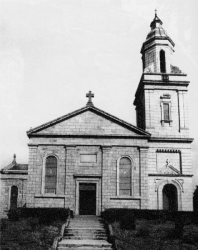
The Church of St. John the Evangelist,
Ballymaghery is an imposing edifice on the outskirts of
Hilltown. The church was extensively renovated in 1998.
LANDS OF CLONDUFF
Forty years afterwards, Queen Elizabeth I granted the
parish of Clonduff to Thomas Smith to colonise, but the grant lapsed to
the Crown as the O'Neills prevented Smith from taking possession of the
lands. Under the reign of James I, the tithes of Clonduff were granted
to James Hamilton, but as his successor sided with the King against
Parliament, the tithes of Clonduff were taken possession of by Sir
George Acheson from Markethill, then by Magill of Gilford, then by
Meades and the Earls of Clanwilliam who continued to hold them until the
Disestablishment of the Church of Ireland in 1869. But whereas the
tithes of the parish had been confiscated and granted to adherents of
the Established Church, the lands of the ancient parish of Clonduff
remained in the hands of the native Catholic inhabitants. The four
townlands of Clonduff-Leitrim, Ballymaghery, Ballyaughian and Ballynanny
were See lands of the Dromore bishopric. In 1610, the occupants claimed
tenant rights and the King granted them leases for ever, subject to a
rent of �2 per townland paid to the Protestant Bishop of Dromore.
The remainder of the parish was settled in 1611 on
various members of the Magennis clan subject to an annual rent payable
to the Crown. Even when the lands passed into the hands of financiers of
English and Scottish origin, and also during the Cromwellian settlement
of Iveagh, there was no appreciable clearance of native peasantry in
Clonduff as shown by poll tax returns in 1659.
At the time of the insurrection of 1641, the four
town-lands were held by Lady Mary Crosby, an English lady. At her death,
these four passed into the hands of the Waring family and were held
until 1834, when Rev. Holt Waring sold his interest to Narcissus Batt
for �33,000. Finally in 1912, Mrs. Essel, granddaughter of Batt,
disposed of the estate to tenants under the land-purchase Acts. The
Downshire estate in Clonduff dates from 1638. In that year, Brian
Magennis and his wife, Elizabeth, gave the rents of Cleomack and
Carcullion to Arthur Hill in settlement of a debt of �16,000. In 1640,
the Hills gained possession of nine townlands in Clonduff. Finally, in
1657, the Hills owned Stang, Lenish, Ballyweely, Mullaghmore,
Ballycashone, Goward and Ballykeel. A weekly market on Monday, and two
fairs yearly on 25th April and 21st September, were granted in 1669. The
remaining lands of Clonduff, Ballygorian and Lisnamulligan were granted
to a Cromwellian supporter named Barker on 22nd May 1657, ultimately
becoming lands of the Annesley estate.
THE REFORMATION AND PENAL PERIOD
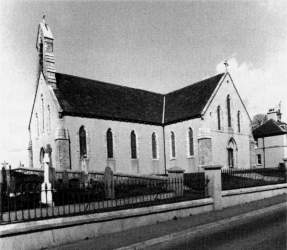
A Mass House had existed in Cabra since
1783. The present St. Mary's Church replaced it in 1865. The
adjoining Parochial House was first occupied in 1930.
The ruins of the parish church and the burial ground
adjoin the main road to Bryansford about half a mile east of Hilltown.
According to an Inquisition of 1657 only the walls were standing then.
Local tradition states that the church was burnt by parliamentary forces
in 1642 or early in the following year. It is likely that the reign of
terror continued until the Restoration in 1660. Mass was said at the
Mass Rock on the mountain called `Alt an tSagairt' - `Priest's
Mountain'. The position of the stone itself, which stands at a vantage
point 1,362 feet above sea-level in a remote and inaccessible part of
the Mourne range, is evidence enough of the dangers people had to face
on hearing Mass in those times when religious intolerance was the rule.
Catholic worship was absolutely proscribed under Cromwell's reign by an
edict of 1653 - any priest who failed to quit the Kingdom within 20 days
was liable to the penalty of a protracted and gruesome death.
According to tradition, a priest, Fr. Eoghan O'Hagan,
was murdered by Colonel Whitechurch and his soldiers along with a number
of those who assisted at the Mass on Alt an tSagairt in the middle of
the 17th. century. During the Penal Era, in the 18th. century, the
constraints were dictated less by religious fervour or fanaticism than
by fear and hatred of the Catholic people on the part of the ruling
class. There were a number of examples recorded where Catholics were
saved from the law by the pitying kindness of their Protestant
neighbours. Moreover, the laws against the practice of religion fell
into abeyance a generation after the passing of the Code, but not those
related to possession of property and political rights. But even after
the practice of religion had come to be tolerated, Mass was generally
said in private houses and at stations with primitive altars in the
open-air.
Concerning the Mass sites in Clonduff during this
period of operation of the Penal Code, there appears to be no
information in public records but. in addition to Alt an tSagairt local
tradition is clear in identifying three other places:
- On the Magennis land in Cabra where St. Mary's Church now
stands.
- In Ballygorian on the land then held by Owen O'
Neill.
- In John O'Neill's corn-mill at Bannvale.
St. Mary's Church, Cabra.
A Mass House on Magennis lands at Cabra was built in
I783 and enlarged in 1832 while Fr. Bernard Murphy was P.P. In I865,
mainly through the efforts of Fr. McMullan C.C. and Rev. Dr. McLeigh
P.P., Cabra Church was rebuilt on a larger scale - much as it now
stands. In I934, the church was extensively renovated and reopened on
Ascension Day, Thursday I0th. May. New Stations of the Cross were
erected at this time. Another renovation was carried out in 1998. A new
granite altar was installed as part of this work, and the sanctuary was
re-designed. The walls were replastered and the church received a new
roof.
St. John The Baptist Church, Ballygorian
The first of the existing church buildings in
Hilltown dates from I805. It is St. John the Baptist, Ballygorian. It
was opened by Fr. James Gilmore P.P. As the plaque bearing the
inscription over the main entrance records, the church was built out of
funds subscribed by all denominations. The site of the church was
granted by the Earl Annesley. It has been painted and renovated over the
years and has had a new heating system installed. St. John the Baptist
Church will be two hundred years old in 2005.
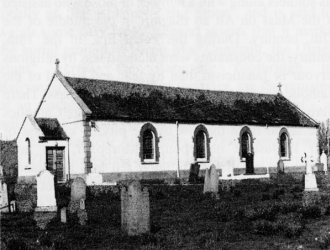
The Church of St. John the Baptist,
Ballygorian, is Hilltown's `Old Chapel'. It was
originally opened in 1805, during the pastorate of Fr.
James Gilmore.
St. John The Evangelist,
Ballymaghery
This splendid building was begun in 1844 and
completed after the Famine in I850. Fr. John McLeigh was a very popular
priest with all denominations and highly respected by the Batt family
who granted the site for the church, the parochial house and
Ballymaghery School. Rev. Dr. Kearns erected the handsome tower in 1900
at the cost of �I,600. The organ gallery was erected in I931 by Fr. Tom
McGrath P.P. Fr. Patrick Keenan transformed the church in I941, when new
marble altars and Stations of the Cross were erected and the grounds
artistically laid out. In I982, Canon Hamill P.P. had the sanctuary
remodelled and a new altar, baptismal font, chair and lectern installed.
The church was also redecorated at this time.
In I998, when Fr. Anthony Davies was P.P. renovations
were carried out with the help of National Lottery funding. The
improvements included remedial works to the existing building, along
with external environmental improvement to the grounds and a new ramped
access for wheelchair users. The church, was also re-roofed and the
existing roof structure strengthened. Internally, areas of plaster were
removed and replaced on those south-facing walls affected by penetrating
dampness. The entire interior was also re-decorated with the replacing
of existing electrical installation and the up-grading of the heating
system.
Ballygorian is contemporary with the church, I805.
Cabra is also contemporary with the church, in 1783. Ballymaghery is
contemporary with the church, 1844. A new portion was blessed on 24th.
April 1932.
BALLYMAGHERY - was built by Rev. John McLeigh after
1850. The newly-constructed house, which replaced it, was officially
opened by Rev. Matthew O'Hare P.P. on 29th. March 1985. Its cost was
�108,000.
CABRA - was completed on 12th. March 1930.
PAROCHIAL HALL
Ballymaghery Hall was built in the early 1900s during
the pastorate of Dr. Kearns and was extended during the 1970s. Cabra old
school became church property in 1932 and was made into a hall in the
late 1980s.
YOUTH CLUB
St. John's Youth Club, Hilltown, was opened on
Wednesday, 28th. November 1986. It was dedicated, at a concelebrated
Mass, by Bishop Brooks. The building was originally a public house but a
face-lift had given it three main units, a magnificent sports' hall, a
conference room and a coffee bar. The Department of Education provided a
very substantial grant towards this provision.
Throughout the period of religious persecution there
existed over the country a system of illegal schools which, as recent
research has shown, produced results of a comparatively high order.
Instruction was provided in the rudiments of learning. According to a
State Inquiry of 173I, there were four illegal schools in Clonduff
Parish, although the teachers' names were not recorded. As time passed
the illegal schools were referred to as "Hedge Schools" from the custom
of taking scholars out of doors in fine weather and placing them in rows
along a hedge. Three hedge schools are mentioned in Clonduff Parish:
Leitrim, Ballygorian and Ballyweely.
LATER SCHOOLS
Kingshill School, was opened in 1834, and was
replaced by St. Paul's Cabra in 1964.
St. Paul's Primary School, Ballykeel, was
opened and blessed by Dr. Eugene O'Doherty on 6th. April 1964 at a cost
of � 12,800.
Cabra School, was built by Gartland for his
workers in 1854 and became church property in 1932.
Ballymaghery boys' and girls' school, opened
in 1857 and was extended later. The new St. Patrick's Primary School was
opened in 1967, at a cost of �52,700. In 1977, two new classrooms were
added. The school's car park was extended in 2003.
MEDIEVAL RECTORS AND ABBOTS
The first rector of Clonduff whose name has come down
to us was Patrick McGinn, appointed by the Holy See in 1407. He
died in 1423. The Abbot of Bangor then took possession of the rectory.
Fr. Mark McBride, a priest of the Diocese of Dromore informed
Rome that this Abbot held the parish illegally. He succeeded in his
claim. The Papal records mentions two other pre-Reformation rectors of
Clonduff. Emerious O'Neill who held it without a title and was
removed and Arthur Magyn (Jun.), appointed on St. Patrick's Feast
Day in 1530. The last pre-Reformation rector was Fr. William O'Dornan.
The first secular pastor of Clonduff was Fr.
Eoghan O'Hagan. Tradition relates that this priest was murdered
while celebrating Mass at Alt an tSagairt. Rev. Dominic McAvoy
was registered as Popish Priest of Clonduff at Downpatrick. He was a
prominent supporter of King James II.
Rev. Patrick Byrne was P.P. in 1704. According
to the report of the Protestant bishop in I73I on the `State of Propery'
in Dromore Diocese, there was one priest and one school but no Mass
House in Clonduff in 173I.
Rev. James Pulleine D.D. circa 1744. He was
the author of an Irish catechism, An Teagasg Criosdaidhe, published in
I782.
Rev. Edmund Derry, was appointed Administrator
of Clonduff on 5th. April. He was appointed Bishop of Dromore in 1801.
Rev. William Fegan, a native of Stang,
succeeded Dr. Deery as P.P. on 26th. July I796. He died in 1804. Rev.
James Gilmore was appointed P.P. in 1804. He erected the church in
Ballygorian in I805. He was transferred to Kilbroney in I808.
Rev. Bernard Murphy, born in Drumgath Parish,
was appointed P.P. in 1808. He erected the Mass House in Cabra. He died
on 6th. August I833.
Rev. John McLeigh, was appointed Administrator
in Clonduff in August 1831 when Fr. Bernard Murphy was ill. He was born
in the parish of Magheradroll and appointed P.P. on 28th. August 1833.
He was responsible for the building of the Church, parochial house and
school at Ballymaghery. Rev. J. McLeigh was appointed Vicar General in
1867 and later died on 4th. March, 1872.
Rev. Patrick McKay was appointed R.P. on I6th.
April 1872. He was born in Lenish in the parish of Clonduff. He died
3Ist. May 1876.
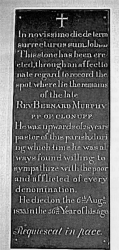
This former pastor of Clonduff is
faithfully remembered in St. Mary's Church, Cabra. Fr.
Bernard Murphy was parish priest from 1808 until 1833.
Rev. John Mooney, was appointed P.P. on 17th.
July 1876. Born in Tamery, parish of Drumgath, he died on I3th. February
I888. During Fr. Mooney's time as Administrator in Upper Drumgooland,
the notorious `Battle of Dolly's Brae' was fought on 12th. July 1849.
Rev. Thomas McGivern, D.D. was appointed P.P.
on 16th. February I888. He became Bishop of Dromore in 1891.
Rev. Joseph Kearns, was appointed
Administrator on 16th. February 1888 and succeeded Bishop McGivern as
P.P. He was born in Derrytagh in the parish of Seagoe. He erected the
tower at Ballymaghery Church and built the Parochial Hall. He founded a
burse for the education of Dromore students in the Irish College, Rome,
and was a generous benefactor of St. Colman's College, Newry. Through
his generosity, too, the office of Ecclesiastical Inspector of Schools
was set up. He died on 1st. May 1923. During the transfer of the lands
of the parish to the people of the parish, the Archdeacon was their
great counsellor and friend securing for many of them much cheaper
transfer rents than they might otherwise have obtained. He organised the
pilgrimage to Alt-an-tSagairt.
Rev. Daniel Grant, was appointed RP. on 23rd.
June 1923. He was born in Mayobridge in the parish of Clonallon. He died
two months after being appointed, on 20th. August 1923. Fr. Grant was
associated with Dr. O'Neill's big improvement and extension scheme to
Newry Cathedral and toured the north of England and the Dioceses of Down
& Connor, Cork, Kerry, Limerick and Killaloe in order to raise funds for
the project.
Rev. John Rooney, was appointed P.P. on 1st.
September 1923. He was born in Mayobridge in the parish of Clonallon.
While Administrator in Newry, he went on a lecture tour to the U.S. on
behalf of Newry Cathedral Building fund. He died on the 20th. June 1930.
Canon Rooney had a wide reputation as a preacher and lecturer and was
well-known as a temperance advocate.
Rev. Thomas McGrath, was appointed on 7th.
July 1930. He was born in Ballydesland in Clonallon Parish. He was the
first P.P. of the new parish of Saval 1920. He died on the 10th. March
1941. Fr. McGrath erected the organ gallery in Ballymaghery Church. 1Ie
was a noted temperance advocate and he began the annual pilgrimage to
Ballyholland Mass Rock, Newry.
Rev. Patrick Keenan, was appointed
Administrator on 30th. November 1936, then P.P. on 13th. March 1941. He
was born in Drumlough in the parish of Drumgath. He was appointed Army
Chaplain in August 1916, and saw action in India, the Middle East, and
Rhine Valley. He retired from the army with the rank of Captain. He died
on 28th. February 1951. Fr. Keenan transformed St. John's Church,
Ballymaghery, making it the finest parish church in the diocese.
Rev. Michael H.O'Hare, D.D. was appointed P.P.
on 2nd. April 1951. He was born in the parish of Donaghmore. He was
transferred to the parish of Dromore in 1952.
Rev. James Murney, a native of Killowen in the
parish of Kilbroney, was appointed P.P. on 6th. November 1952, He died
on 7th. January 1960.
Rev. James Burke, was appointed P.P. on 1st.
February 1960. He was born in Lurgan in the parish of Shankill. He died
on 4th. December 1967. He had a fine baritone voice and for many years
was one of the official diocesan chanters.
Rev. Michael McConville, was appointed P.P. on
2nd. January 1968. He was a native of Saval parish. He resigned as P.P.
in October 1981 and was appointed C.C. in Cabra. He died on 30th.
December 1987.
Rev. Edward Hamill, was appointed P.P. in
October 1981. He was a native of the parish of Magheralin. Canon Hamill
remodelled the church at Ballymaghery. He erected a new altar in 1982,
placed the baptismal font within the sanctuary and redecorated the
church. He was transferred to Clonallon parish as Administrator on 25th.
January, 1984.
Rev. Matthew O'Hare, was appointed P.P. on
26th. January 1984. The new parochial house was being built during his
time and he took up residence in it on 29th. March 1985. He was
transferred as P.P. to the parish of Seapatrick on 17th. January 1988.
Rev. Malachy Finegan, was appointed P.P. on
17th. January 1988. He was a native of Newry Parish. He was on mission
in the diocese of Kildare & Leighlin at Mountmellick, 1973-76. Fr.
Finegan was President of St. Colman's College 1976-87. He died on 15th.
January 2001, having retired in September 1995.
Rev. Anthony Davies, was appointed RP. on 8th.
September 1995. He is a native of Tandragee in the Parish of Ballymore
and Mullaghbrack in the Archdiocese of Armagh. He undertook renovations
of Cabra and Ballymaghery Churches. With the help of National Lottery
money, the two projects were carried out successfully.
Rev. Patrick Morgan, 1771; Rev. Edmund Derry, 1771;
Rev. William Fegan, 1796-1801; Rev. Bernard Magennis, 1798; Rev. Daniel
Magennis, 1826; Rev. Thomas McGivern, 1826-1831; Rev. Bernard O'Loughlin,
1831-4; Rev. Thomas Brady, 1835-6; Rev. John MacHugh, 1936-8; Rev. John
Keaney,1838-40; Rev. John Bryne, 1839-44; Rev. Patrick McKay, 1840-3;
Rev. John Mooney, 1844; Rev. Terence Fegan, 1844-8; Rev. Michael Maginn,
1848-51; Rev. Eugene McMullan, 1850-69; Rev. John McGrath, 1869-74; Rev.
Edward McCartan, 1869-81; Rev. John Lowry, 1874-6; Rev. James Lowry,
1876-8; Rev. Joseph Kearns, I88I-8; Rev. John Savage, I8851903; Rev.
Francis J. O'Hare, 1890-95; Rev. James Grangle, 1899-1907; Rev. Peter
McEvoy, I903-4; Rev. George McCorry, 1904-20; Rev. Edward McGivern,
1907-20; Rev. James McMurney, 192024; Rev. Michael McCartan, 1920; Rev.
Michael McClorey, S.T.L. I920-30; Rev. Hugh Francis Gallagher, 1924-31;
Rev. Michael F. Gallogly, 192431; Rev. Patrick Keenan, 1931-6; Rev.
Bernard J. Murney, 1941-56; Rev. James Murtagh, 1956-60; Rev. Bernard
Treanor, 1961-72; Rev. Oliver Mooney, 1972; Rev. Seamus Laverty, 1972-5;
Rev. Arthur Bradley, 1975-83; Rev. Kieran McPartland, 1983-88; Rev.
Peter Lennon, 1988-89; Rev. Peter McNeill, 1990-97; Rev. Tony Corr,
1997-2000; Rev. Martin McDonagh CSSp. 14th. August, 2003 - ad nunc.
CURATES IN CABRA
Rev. M. McClory, S.T.L. was the first resident priest
in Cabra in 1930. Rev. Michael Gallogly, 1930-1; Rev. Patrick Keenan,
1931-6; Rev. James Murney, 1936-41; Rev. Patrick McCartan, 1941; Rev.
Peter Campbell, 1941-51; Rev. Patrick Francis Boyd, I95158; Rev. Anthony
Owens, 1958-62; Rev. John McCauley, 1962-67; Rev. Patrick McAnuff,
1975-80; Rev. Gerard Conway, I980-81; Rev.Michael McConville, 1981-86;
Rev. James Masterson, CSSp, 1986-87 (on loan); Rev. Joseph O'Hagan, 1987
ad nunc.
HISTORIES OF CLONDUFF PARISH
Clonduff Parish, Past and Present by Francis McPolin
M.A.Ph.D. A pamphlet of 48 pages (illustrated) was published in 1936.
A brief Historical Sketch of the Parish of Clonduff
by Padraic Keenan, Newry. A pamphlet of 32 pages (illustrated) was
published in 1941.
The Clonduff Story `1887-1984' by Mr. P.D. Kearns,
Newry. Published in 1984, it gives an account of G.A.A. activities in
the parish.
Rev. James Dargan, I935-8; Rev. James B. Mooney,
I939-41; Rev, James B. McCartan, 194I-46; Rev. James Fitzpatrick,
1946-8; Rev. Aloysius Joseph Sweeney, 1948-49; Rev. Bernard Treanor,
I949-55; Rev. James Fitzpatrick, 1955-62; Rev. Peter McConville,
I962-68.
The Sisters of St. Joseph of Newark known as St.
Joseph's established a convent at Cabra in Clonduff Parish. Their
convent was blessed and formally opened on 19th. March, 1935 by Dr.
Mulhern. The new convent was under the leadership of Rev. Mother Mary
Aloysius and was formerly known as 'Cabra Towers'. It had been
purchased, at the cost of �500, from the representatives of the late
John McKay in October 1934. The object of the foundation was to provide
members of the Order with a preliminary training prior to embarking upon
their labours in the U.S.A. and elsewhere. The Sisters of Joseph left in
1968.
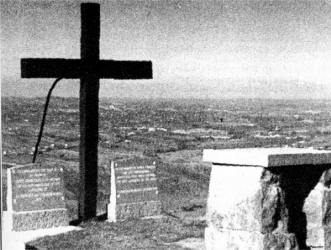
A legacy of the Penal era in Clonduff Parish
is Alt-an-tSagairt: The Priests' Mountain.' Local tradition
associates this sacred site with the martyrdom of Fr. Eoghan
O'Hagan in the seventeenth century.
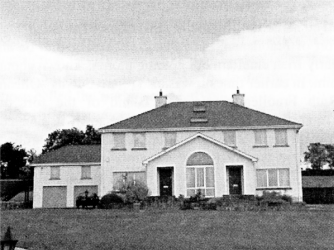
The original parochial house
at Ballymaghery was built c.1850. The present
house replaced it in 1985.
 |